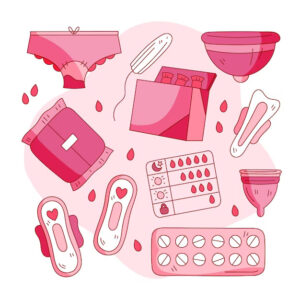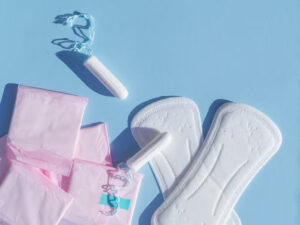Swimming during menstruation can be a concern for many individuals due to the fear of leakage and discomfort. Tampons, pads, and menstrual cups are popular menstrual products that provide different options for managing menstrual flow during water activities. This article examines the benefits of using tampons for swimming and compares them with pads and menstrual cups to help individuals make informed choices based on their needs and preferences.
Secure and Discreet Protection
Tampons offer a secure and discreet form of protection during swimming. When properly inserted, they stay in place within the vaginal canal, preventing menstrual blood from entering the water. This level of protection allows individuals to swim with confidence, knowing that they are not likely to experience any leakage.

In contrast, pads are not suitable for swimming as they are designed to be worn externally and may not provide adequate protection in water. Menstrual cups, on the other hand, can be used for swimming, but some individuals may find them less secure compared to tampons, especially if they are still getting accustomed to using cups.
Comfort and Freedom of Movement
Tampons offer a high level of comfort and freedom of movement during water activities. Since they are worn inside the body, they do not cause chafing or discomfort that may be experienced with pads. Tampons are also less likely to be felt during swimming, allowing individuals to move freely and engage in various water sports without restriction.

Pads, however, may become uncomfortable and heavy when wet, affecting mobility and causing potential irritation. Menstrual cups, although comfortable for many users, can sometimes shift or cause discomfort during swimming if not positioned correctly.
Reduced Water-Related Infections
Using Best tampons for swimming can help reduce the risk of water-related infections. Menstrual blood, when mixed with water, can create a favorable environment for bacteria growth, potentially leading to infections. Tampons prevent menstrual blood from coming into contact with pool water, minimizing the risk of infections for both the swimmer and others in the pool.
Pads, if used while swimming, can absorb water and become less effective in managing menstrual flow, increasing the risk of leakage and potential bacterial growth. Menstrual cups, if not adequately cleaned and reinserted, may also introduce bacteria into the vaginal canal, leading to infections.
Less Environmental Impact
In terms of environmental impact, tampons can be a more sustainable choice compared to pads, especially disposable ones. Many tampons are made from biodegradable or organic materials, reducing their contribution to landfill waste.
Pads, particularly disposable ones, generate a significant amount of waste, as they are discarded after single use. Although some reusable menstrual cups can be an environmentally friendly option, their production materials and cleaning process may have their own environmental impact.
Variety of Absorbencies and Options
Tampons come in various absorbencies to cater to different flow levels, allowing individuals to choose the most appropriate option based on their needs. They also offer a range of applicator and non-applicator types, providing flexibility and comfort during insertion.

Pads also come in different absorbencies, but their external design limits the range of activities they can be used for, especially swimming. Menstrual cups have varying sizes and capacities, providing choices for different individuals, but they require a learning curve for proper insertion and removal.
No Interference with Swimwear
Tampons do not interfere with swimwear, as they are entirely contained within the vaginal canal. This ensures a seamless and discreet appearance, allowing individuals to wear their preferred swimsuits confidently.
Pads, if used for swimming, can be visible underneath swimwear and may affect the overall look and comfort. Menstrual cups can also cause slight visibility issues, depending on the individual’s anatomy and the cup’s position.
Minimal Water Absorption
Tampons are designed to absorb menstrual flow directly at the source inside the vaginal canal. Unlike pads that may become saturated with water during swimming, tampons do not absorb water from the pool or the ocean. This means they retain their effectiveness in managing menstrual flow even during extended periods in the water.

Pads, when exposed to water, can become heavy, lose their adhesion, and may even lead to leakage. Menstrual cups, while not affected by water absorption, can potentially dislodge or cause discomfort during swimming if not correctly positioned.
Disposal Convenience
Tampons are typically disposable, which makes them a convenient option for many individuals. After use, tampons can be discreetly wrapped and disposed of in designated waste bins or trash receptacles. This easy disposal process ensures minimal hassle for users during their swimming experience.
Pads, particularly disposable ones, require proper disposal as well, but they can be more challenging to conceal due to their size and potential leakage when wet. Menstrual cups, while reusable, need to be rinsed and cleaned after use, which may not be as practical in certain swimming settings.
Hygienic and Odor-Free for pads
Tampons help maintain excellent menstrual hygiene during swimming. By preventing menstrual blood from entering the water, they eliminate the risk of creating odor or discomfort for the swimmer and others in the vicinity. The internal placement of tampons ensures that there is no external exposure to menstrual blood.
Pads, especially if exposed to water, may result in an unpleasant odor due to the combination of menstrual blood and water. Menstrual cups can also contribute to odor if not adequately cleaned or if they are worn for extended periods without proper maintenance.
Ease of Use
Tampons are generally easy to use, and with practice, insertion becomes a straightforward process for most individuals. Applicator tampons offer additional assistance for comfortable and precise placement. Once inserted, tampons do not require further adjustments, allowing swimmers to focus on enjoying their time in the water.
Pads, while straightforward to apply, may require readjustment or replacement during swimming due to water absorption or shifting. Menstrual cups, while providing long-lasting protection, may take some time to get used to during insertion and removal, especially for first-time users.
Ideal for Active Lifestyles
For individuals with active lifestyles, such as athletes or frequent swimmers, tampons offer the advantage of reliable protection without impeding movement. They are discreet and unobtrusive, making them an ideal choice for individuals who want to maintain their active routines during menstruation.
Pads can cause discomfort and chafing during physical activities, which can be particularly inconvenient during swimming. While menstrual cups can be suitable for active lifestyles, some users may find them less secure during rigorous physical activities.
Individual Sensitivities and Allergies
Tampons come in various materials, including cotton and other hypoallergenic options, catering to individuals with sensitivities or allergies. Those with latex allergies or sensitivity to certain materials can find tampons specifically designed to meet their needs.
Pads can cause skin irritation and discomfort, especially for individuals with sensitive skin. Menstrual cups, made from medical-grade silicone, may not be suitable for those with silicone allergies, and some individuals may need to explore alternative materials.
Conclusion
Using tampons for swimming offers several benefits, making them a popular choice for individuals looking to enjoy water activities during their periods. Tampons provide secure and discreet protection, allowing for freedom of movement and reducing the risk of water-related infections. Additionally, they come in various absorbencies and options to suit different needs.
When comparing tampons to other menstrual products, such as pads and menstrual cups, tampons excel in comfort, convenience, and environmental impact. While pads may not be suitable for swimming due to potential discomfort and visibility, menstrual cups can be used but may require some getting used to. Ultimately, the choice between tampons, pads, or menstrual cups depends on individual preferences, flow levels, and environmental considerations. By understanding the benefits and differences of these menstrual products, individuals can make an informed decision and enjoy worry-free swimming experiences during their periods.



